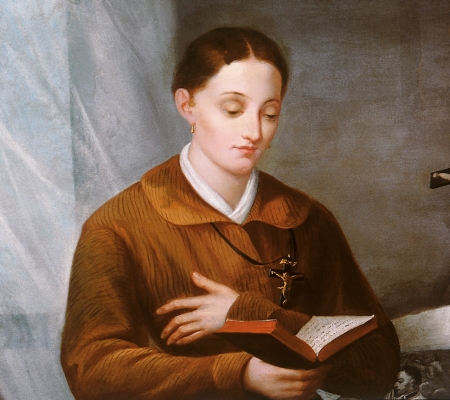Saint Bartolomea Capitanio

BARTOLOMEA, THE DELIGHT OF CHARITY
In these pages, we wish to present the person of Bartolomea Capitanio, canonized in Rome by pope Pio XII on 18 May 1950 together with Vincenza Gerosa. She presents to us a model of holiness that is very real and in harmony with the indications of St. John Paul II, who proposes to the third millennium Christians to aspire towards the “high standard” of Christian living (NMI, n.31). It is also in accord with the recommendations of pope Benedict XVI in the encyclical Deus Caritas Est (cf. n. 18) and that of Pope Francis in the apostolic exhortation Gaudete et Exsultate (cf. nn. 3-5).
Bartolomea Capitanio is born at Lovere, a flourishing commercial center on the western bank of Lake Iseo, on 13 January 1807, as the first born of Modesto Capitanio and Caterina Canossi. Of the six children born after her only Camilla survives, because all others die at a young age. Her father, merchant of grains, manages a small shop with which he maintains the family. The girl grows vivacious and dynamic, gifted with an exceptional intelligence.
Her mother, unable to follow her due to work in the shop, and to keep her away from dangers and to give her proper instruction entrusts her to the sisters of the Poor Clares who had a monastery in Lovere where they ran a school for the girls, according to the Napoleonic laws of the time.
Here just at 12 years of age – as witnesses attest – having chosen the longest straw in a game, that indicated who would have become a saint first, she decides really to become a “saint, a great saint, a saint soon”. Discovering the tangible signs of God’s love in her life, won over and fascinated by this immense love, unmerited and gratuitous, she feels the need to respond to it with the whole strength of her exuberant and determined/strong-willed nature. She understands that there is no other better way to reciprocate God’s love than that of loving concretely one’s brothers and sisters, those whom He loves as He has loved her and for whom He did not hesitate to descend on earth, to offer His life on the cross and to give himself totally in the Eucharist. And so, as soon as she came out of the monastery, without disregarding her family duties, she takes care of the needy persons of her place: the girls in moral danger for whom she opens a small school with the help of the parish priest; she revives with brilliant initiatives the oratorio that has been already started by Caterina Gerosa in her wealthy house; the abandoned sick and those who were in the hospital, that was also begun by “Lady” Caterina with the bequest of her uncle. She visits the prisoners and the poor; she keeps in contact with many of her companions through her frequent correspondence and with the priests of the neighbourhood to favour the renewal of Christian practice after the outburst of irreligiousness and anticlericalism that had turned Italy upside down following the French revolution. The passage of Napoleonic army had left the population in a deep material, moral and spiritual desolation.
The activity of Bartolomea is untiring, sustained by an intense prayer that pervades every second of her day, lived in a spousal intimacy with her Lord. She understands that in order to give continuity to the works initiated, it is necessary to begin an Institute “whose aim should be: the Works of Mercy”. With the support of the parish priest and the help of her spiritual father, don Angelo Bosio, amidst difficulty and tribulation, she gives it a start in an extremely precarious situation, in a poorest house, with only one companion, Caterina (later Sr. Vincenza). From five months of its beginning, a grave pulmonary sickness takes her to tomb within three months at only 26 years of age.
She accepts it as the call of the Lord with serenity, with the certainty that from heaven she would have helped the Institute more than on earth. At her death, everything seemed to end because Caterina, already mature in years, does not feel capable of the project of Bartolomea. Nevertheless, solicited by the parish priest and supported by don Bosio, in obedience, she takes it forward with fidelity and holiness of life. Thus the Institute grows quickly expanding in Lombardy-Venice and in Tyrol.
In 1860 the sisters were requested for Bengal (India) and following it, they continue to spread, going where their presence was called for because “the need is great and urgent”, just as the Foundress used to desire
Today they are present in 20 Countries in four continents. For this reason, the Institute has acquired a clear international physiognomy. Everything sprang forth from that small seed in the beginning, sown with trust in the Lovere soil, which had accepted to die in order to let the Lord to make it fruitful for the necessity of men and women of their and our time.
The Sisters of Charity of the Saints Bartolomea Capitanio and Vincenza Gerosa (SCCG) grateful for the gift that God has given them and to the whole Church commit themselves to witness, with a life dedicated to charity, to the Redeemer’s ardent love for every man and woman, of any race, language, culture, religion and social origin, as Bartolomea and Vincenza did.
They are familiarly called Sisters of Maria Bambina because they preserve in the shrine in Milan, via S. Sofia, 13, an effigy of baby Mary gifted to the Institute in 1842.
13.1.1807 Bartolomea is born; she is the first-born of Modesto Capitanio and Caterina Canossi
14.1.1807 receives Baptism from the parish priest Giacomo Pedretti
06.4.1812 sister Camilla is born
1817 she receives her first communion
11.7.1818 enters the monastery of the Poor Clares
1822-1824 she remains there as an assistant teacher
18.7.1824 returns to the family
1824 goes to oratorio in the house of Caterina Gerosa, with whom she develops friendship.
1825 starts a school in her own house
11.1826 she becomes the treasurer and director of the hospital, open in a building donated by Gerosa
1829 she consecrates herself with the vow of charity to the neighbour
12.6.1830 she is recognized suitable for teaching
26.4.1831 writes her intuitions regarding the Institute she wishes to begin
17.10.1831 her father dies, assisted lovingly by her
22.3.1832 the house ‘Casa Gaia’ is purchased to become the house of the Institute
21.11.1832 Bartolomea and Caterina join together to begin the Institute in the presence of the parish priest don Rusticiano Barboglio and don Angelo Bosio
1.4.1833 Bartolomea falls gravelly ill
26.7.1833 dies, leaving Caterina the task of continuing the work just begun
18.5.1950 she is declared saint together with Caterina (Sr. Vincenza) by Pope Pio XII.
To know more visit the site: www.suoredimariabambina.org




